<Previous Displaying 2/2 Page 1, 2
View Article as Single page
ESTIMATE-THE-STRETCH ROPE
Another method to estimate the stretch that is not labor-intensive and also can show a crew exactly how its hoseline will play out around obstacles, corners, stairs, and so forth is to use an “estimate-the-stretch” rope to simulate the hose stretch. As shown in photo 1, it simulates the stretch in a hallway. This consists of a bag with 200 feet (the length of preconnects in my department) of rope and a couple of carabiners. We use this rope to estimate our stretches at garden apartments, warehouses, high-rises, and even some single-family dwellings that are set far back from the street. Easily deployed from the bag, the rope gives us a visual of how the hoseline will look when stretched. It also helps us to see where any catch points may be that may snag a coupling (e.g., corners and other obstacles). It answers the question of whether the preconnect will be adequate, and it can be packed up just as quickly as it can be deployed. There’s nothing better than training as we fight-i.e., getting the company together to perform the drill in gear and pull the hose. But in conducting a preplan, my company feels the rope is the way to go so a busy crew doesn’t have to pack up hose in a hurry to respond to another call. It also prevents damage to tile floors from hose couplings (photo 1). Using this rope to preplan hose stretches has great public relations appeal, too. This apartment building’s residents welcomed my engine company and enjoyed seeing their local fire department personnel out conducting such a preplan.
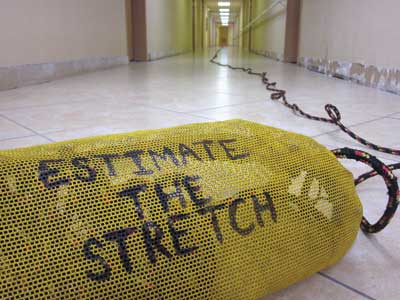 |
| Photos by author. Click to view video |
SUPPLIES NEEDED
To assemble this training tool, you will need the following:
- -One rope bag of any kind. Alternatively, use a five-gallon bucket from a hardware or home-improvement store and cut a hole in the top and in the bottom.
- -Two 100-foot sections of 3⁄8-inch rope. Each section should be a different color.
- -Three carabiners (two small and one large).
- -One eight-foot section of 3⁄8-inch rope. This is the length of my department’s standpipe drop section of 2½-inch hose, which is attached to a pressure gauge and a gated wye.
To assemble this training tool, cut each 100-foot rope section into two 50-foot sections. Next, tie the ends of two ropes of different colors together with a simple figure-eight follow-through knot. This simulates a coupling (photo 2).
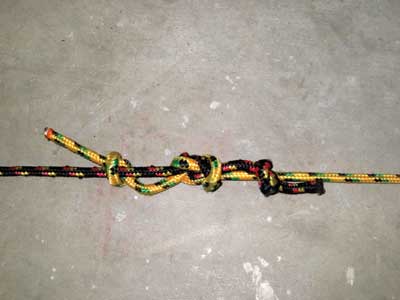
When it is completely assembled and ready to use, you will have 200 feet of rope, tied together in 50-foot sections with a small carabiner at each end, one of which represents the nozzle (photo 3).
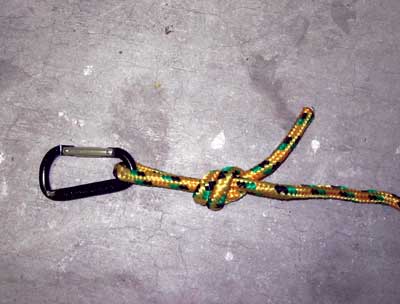
Stretch this rope at a building for which you want to preplan a hose stretch. The alternating colors will allow your crew to visualize each 50-foot section of “hoseline” and the “couplings.” Knowing where each coupling will be in a stretch will help a crew determine where to place members on the line, especially when estimating a stretch up a staircase. Another benefit of seeing the approximate location of each coupling during a stretch is to ensure that you will have at least 50 feet of hose to work with at the door (photo 4).
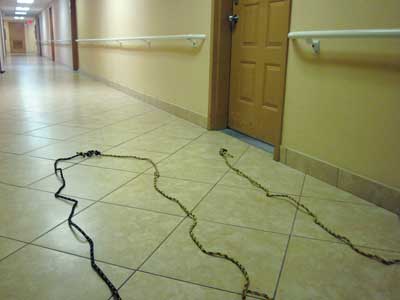
Remember, just because your nozzle can reach the front door does not mean that it will reach the seat of the fire once advanced inside. To make your stretch a success, the advanced line must be able to reach all areas of the structure involved with fire.
Adding the short eight-foot section of rope to this training tool allows my crew to estimate the stretch at high-rises as well. By snapping the eight-foot section to the standpipe in a stairwell using the large carabiner (photo 5), we can determine if our high-rise hose bundles can reach those “top-floor, last-door” fires (photo 6).
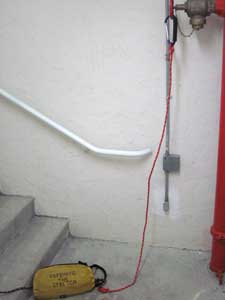
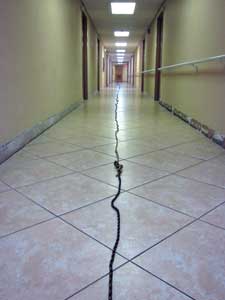
My department’s high-rise hose bundles are two 75-foot sections of 1¾-inch hose and three 50-foot sections of 2½-inch hose. Either way, this gives us 150 feet of hose for high-rise fires. Since our estimate-the-stretch rope is 200 feet long, we can simply untie the last 50-foot section of rope to see just how far our high-rise hose bundles will get us. Remember, the lengths of rope used for this project are equal to lengths of hose carried on my department’s apparatus. If your department varies, then make the adjustments in the numbers to reflect your preconnected hoselines.
As with firefighting operations, stretching and advancing hoselines takes planning, practice, and training. Stretching on a dwelling with just a preconnect is part of any engine company’s bread-and-butter operations. Don’t let complacency sneak into your mindset when it comes to stretching the initial attack line. Preplan your first-due territories. Look at buildings as you drive by and imagine your stretch for these structures. There will be a time when you have a stretch that requires an out-of-the-box decision. Will the preconnect to the front door be sufficient? Will you have to stretch the hose up a staircase? Will you have an extended stretch through a courtyard and use a portable standpipe operation? How many corners or obstacles will the hose have to go around? How many firefighters will be needed to put the initial line into operation? These are questions that you must know the answers to before you respond for a reported fire. Be proactive and preplan, and estimate stretches with this rope, or use whatever method works for you so that you are well-prepared and not surprised if your hose stretch comes up short. An initial stretch that comes up short may just be the first thing that goes wrong in a snowball of events that commonly leads to injuries and line-of-duty deaths. If you fail to preplan, then your preplan is to fail.
Andy Fredericks gave us so many fire service truths that we can all learn from. I learned from his teachings the basics of stretching, advancing, and flowing from the initial attack line. Another great line of his is, “Take the time to make the time.” Taking a few extra moments to think about your plan of attack, slowing down on the fireground, and not becoming complacent will ensure the right hose is deployed to extinguish the fire. This will pay huge dividends in efficiency and the operational safety of crews working on the scene.
The fire service, like all professions, is always evolving and adapting to new technologies. The way we train and operate is becoming more and more advanced. We should regularly practice the fundamentals of stretching and advancing hoselines to reinforce our muscle memory. Knowing beforehand whether these hoselines can effectively reach the fire building’s door and all areas inside is just another advantage that firefighters and fire officers need to have working for them. Lives depend on it!
DANNY MORAN is a lieutenant with the Fort Lauderdale (FL) Fire Department, assigned to Engine 46. A fire service instructor III and a live-fire training instructor at Miami Dade College School of Fire Science, Moran is a hands-on training (HOT) instructor for the Orlando Fire Conference engine company operations class and helps coordinate the Fort Lauderdale Fire Expo, where he is also a HOT instructor. Moran is the president of the South Florida Fraternal Order of Leatherheads Society (FOOLS) and has a bachelor of science degree in criminal justice from Florida International University.
<Previous Displaying 2/2 Page 1, 2
View Article as Single page
Fire Engineering Archives

